 In the town where I live, there is a private lake in a neighborhood of single-family homes. The little body of water was created by developers who dammed a local creek; now a neighborhood association levies annual fees for use of the lake for swimming, fishing and boating. In the past month, the neighborhood residents were surprised by an influx of birds that they do not usually see and some photos of the new avian visitors began circulating.
In the town where I live, there is a private lake in a neighborhood of single-family homes. The little body of water was created by developers who dammed a local creek; now a neighborhood association levies annual fees for use of the lake for swimming, fishing and boating. In the past month, the neighborhood residents were surprised by an influx of birds that they do not usually see and some photos of the new avian visitors began circulating.
Given my interest in wildlife and birds, some colleagues passed on a couple of photos to me and one couple kindly invited me to come visit so that I could see the new arrivals in person. They were especially curious about the identity of a few ducks. When I arrived, no ducks were in sight, but at least 80 double-crested cormorants (Phalacrocorax auratus) were hanging out in crowds on two floating docks.
Their tightly-packed presence had displaced the Canada geese (Branta canadensis), who are more common lake residents. A group of 11 geese were off in the distance on shore leaving the open water to the visiting avian groups.
Some of the cormorants couldn’t fit onto the platforms, so they swam around in the company of the many dozens of ring-billed gulls (Larus delawarensis) of all ages who were swarming the waters as well.
From time to time, the gulls would begin edging their way onto the platforms, eventually taking up space vacated by the cormorants. There are both adult and immature gulls in the crowd.
 From time to time, the gulls launch themselves into the air for aerial forays which end in dives down to pick up a fish, of which there still seem to be plenty. This is because the shad population with which the lake was apparently stocked is dying off as a whole.
From time to time, the gulls launch themselves into the air for aerial forays which end in dives down to pick up a fish, of which there still seem to be plenty. This is because the shad population with which the lake was apparently stocked is dying off as a whole.
Why is this happening? I don’t know the species of shad with which the lake was stocked, but it appears that threadfin shad (Dorosoma petenense) are common in the Southeastern USA and often introduced as forage fish for the bass and catfish that fisher-people seek. The shad are very sensitive to changes in water temperature; when it goes below about 42° F (5.5° C), they expire. In the past 6 weeks, we had an unusual early winter storm with about 8-11 inches of snow, followed by days and days of cold rains. Sometimes, it is cold 24 hours long; other days have nights and dawns below freezing and then afternoon temperatures of 50-60° F (10-17° C). The shad die-off is a result.
The newly arrived birds are obviously enjoying the easy pickings. When the gulls drop down to snatch a fish, they are almost always pursued by other gulls who try to make them drop the prize.
Even when they alight with a fish firmly held in their beaks, other gulls harass them in an attempt to make them give up the meal.
The shad often appear to be too large for the gulls to swallow. I saw several gulls try to position them to get them down their gullets but the fish just wouldn’t go down. So they drop the fish in the water and then try to pick off pieces for easier eating, while fending off neighboring gulls.
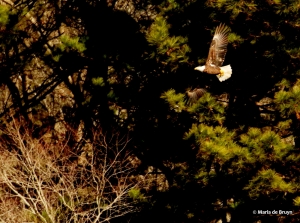 It is unclear to me how the birds who don’t usually populate the lake in winter knew that a spontaneous buffet had appeared. In addition to the cormorants and gulls, a group of seven bald eagles (Haliaeetus leucocephalus) was also fishing when I visited. There were some almost full adult eagles (with mostly white heads and tails) and several immature birds of varying ages (eagles reach maturity at 5 years of age). I guess that they came over from Jordan Lake, which is quite a fair distance away. Searching the Internet has not yet given me an answer to this question.
It is unclear to me how the birds who don’t usually populate the lake in winter knew that a spontaneous buffet had appeared. In addition to the cormorants and gulls, a group of seven bald eagles (Haliaeetus leucocephalus) was also fishing when I visited. There were some almost full adult eagles (with mostly white heads and tails) and several immature birds of varying ages (eagles reach maturity at 5 years of age). I guess that they came over from Jordan Lake, which is quite a fair distance away. Searching the Internet has not yet given me an answer to this question.
I didn’t see the eagles harass gulls who had gotten a fish but they were very carefully watching one another. When the eagle below managed to get a snack, other immature eagles closely followed him/her. A sub-adult who got a fish was harassed by an immature bird as well.
The eagles soared overhead and were joined at one point by a beautiful red-tailed hawk (Buteo jamaicensis). The larger raptors let the hawk fly alongside them with no problem.
It was quite a chilly morning when I got to see the visiting aquatic birds, so I only stayed a short time. But my friends invited me to return for another visit, which I hope to do soon as there is no telling how long it will take the visiting birds to eat the easily available shad. And the ducks? I was able to get one rather indistinct photo of a threesome across the lake and helpful folks in a Facebook group confirmed my guess – they are ruddy ducks (Oxyura jamaicensis). Maybe I can get a decent photo of them next time. 🙂

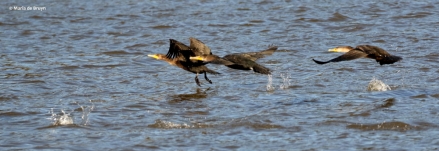









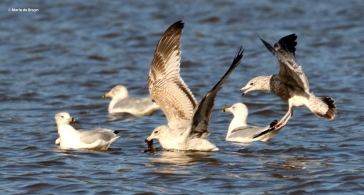










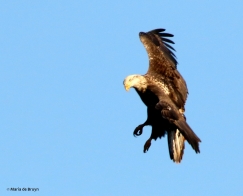


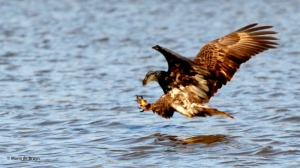


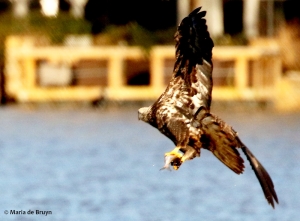


The Chapel Hill Christmlas Count was Sunday and my count area includes the lake. I counted 145 Ring-billed Gulls, 120 Double-crested Cormorants, 6 Ruddy Ducks, 3 Bald Eagles, 7 Canada Geese, and 2 Mallards. Very nice photos of the eagles.
LikeLiked by 1 person
Thanks for sharing your count results. I guess I was lucky to see many more eagles on the previous morning.
LikeLike
Super series Maria.
LikeLiked by 1 person
Thanks, Karla. It was pretty cold and I’m glad I had hand-warmers in my gloves! Next time, I’ll try to get somewhat better photos of the eagles if they are still there.
LikeLike
It will be interesting to know how these birds know that there are plenty of easy meal there.
LikeLiked by 1 person
Yes, I agree, it would be interesting to find out how they discover this. Perhaps some birds that usually hang out at the little lake (e.g., gulls) somehow communicate it to gulls further away and then the other birds follow them?
LikeLike
This is terrific. Friends live on that lake and I’ve seen the birds at a distance. Your photos really bring them in for closer looks. Thank you!
LikeLiked by 1 person
Glad you liked seeing them a little closer; of course, I would have liked them to be even closer still! 🙂 I did go back a few days later but many of the birds, including eagles, seemed to have gone. Perhaps they had eaten most of the shad. Happy New Year!
LikeLike